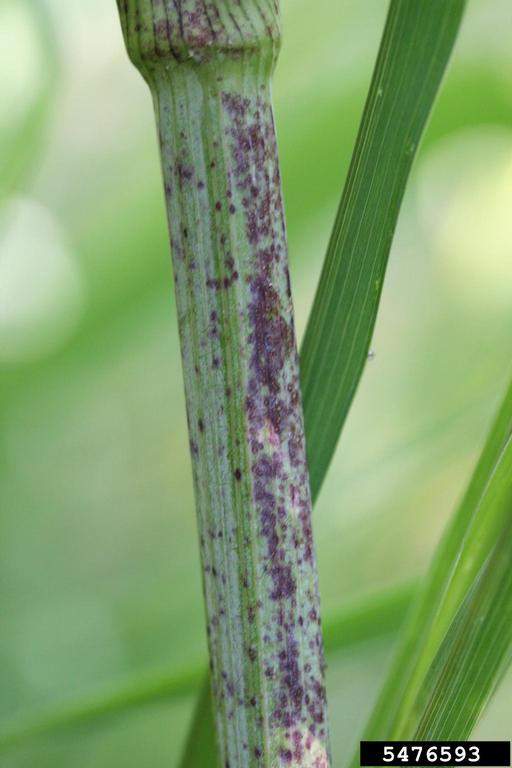

Dr. Bruno Pedreira
Associate Professor and Extension Forage Specialist
Department of Plant Sciences
Director, UT Beef & Forage Center
P: 865-974-3535
Co-Authors: Dr. Gary Bates, Head, Department of Plant Sciences; and, Dr. Larry Steckel, Extension Weed Specialist, Department of Plant Sciences
Poison hemlock (Conium maculatum) is a toxic plant that poses a significant risk to livestock. Its presence in pastures and hayfields can result in fatal poisoning if consumed. As cattle producers, it is crucial to be aware of how to identify poison hemlock, understand its toxicity, and take proactive measures to eliminate it from pastures.

How to Identify Poison Hemlock
One of the key challenges in managing poison hemlock is its resemblance to other non-toxic plants, such as Queen Anne’s lace (Daucus carota). Both plants share similar white, umbrella-shaped flower clusters (Fig. 1). However, there are distinct differences that can help differentiate poison hemlock from harmless look-alikes:
- Purple Spots on the Stem: Poison hemlock has purplish spots or streaks on its smooth, hollow stems (Fig. 2). This is a crucial feature for proper identification.
- Leaf Shape: Poison hemlock leaves are fern-like and often have a strong, unpleasant odor when crushed.
- Size and Growth Pattern: Poison hemlock can grow up to 8 feet tall, with branched stems and clusters of white flowers, typically appearing in late spring.

Toxicity and Its Impact on Cattle
Poison hemlock contains toxic alkaloids that can cause severe poisoning in cattle if consumed. Even small amounts can be deadly. The plant affects the central nervous system, leading to symptoms like muscle tremors, difficulty breathing, and eventually death. The toxicity remains in dried plants and hay, meaning that feeding hay contaminated with poison hemlock could also result in fatalities.
This is why it’s crucial to avoid baling hay that contains poison hemlock, especially if the plant has not been completely removed. The risk of toxicity persists in hay, even after it has been dried and stored. Therefore, it is advised not to feed hay from fields where poison hemlock has been present.
Management and Control of Poison Hemlock
Effective control of poison hemlock requires early intervention. The best time to treat poison hemlock is in early May, before the plant matures and sets seed. At this stage, poison hemlock is most vulnerable to herbicides.
- Herbicide: Applying 18-20 ounces of Duracor herbicide is an effective method to control poison hemlock. It is best to spray at the early bloom stage. This herbicide works by targeting the plant’s root system, ultimately killing it before it can spread further.
- Mowing: Mowing poison hemlock can help reduce its presence, but this method alone will not eliminate the plant. While mowing will prevent the plant from reaching maturity and producing seeds, poison hemlock may still regrow from its roots.
Can We Take the Risk?
The bottom line is that we cannot afford to take the risk of poison hemlock in beef cattle production. The toxic alkaloids remain in the plant even after it is cut and dried. So, feeding hay that contains poison hemlock could result in poisoning and death, and unfortunately, there is no reliable way to determine how much of the plant needs to be consumed to cause harm.
If you are concerned about poison hemlock in your hayfields, it is highly recommended to take immediate action:
- Remove Poison Hemlock Early: Most of the plant can likely be removed before the first cutting of hay. After removal, any regrowth should be sprayed with Duracor to prevent further issues.
- Avoid Feeding Hay with Hemlock: Do not risk feeding hay from fields where poison hemlock was present, even if it was mowed down. The toxic alkaloids will remain in the dried plant.
Queen Anne’s Lace: Not a Threat, But Beware of Similarities
It’s important to note that Queen Anne’s lace (Daucus carota), also known as wild carrot, is not toxic to cattle. While it may look similar to poison hemlock, it does not pose a danger if consumed. However, Queen Anne’s lace can reduce the nutritive value of hay, which can affect the overall quality of feed. The key difference between the two plants is the absence of purple spots on the stem in Queen Anne’s lace.
Bottom Line: Don’t Take the Risk
In summary, poison hemlock is a dangerous and toxic plant that requires vigilance in beef cattle production. Proper identification, early control measures, and careful management of hayfields can prevent losses from this plant. Always prioritize safety by removing poison hemlock from pastures and hayfields, and never risk feeding hay that may contain it.
Picture Credits
Fig. 1. Flowering poison hemlock. Digital image. Accessed 03 June 2025. https://www.eddmaps.org/species/subject.cfm?sub=4365
Fig. 2. Stem with purplish spots. Digital image. Accessed 03 June 2025. https://www.eddmaps.org/species/subject.cfm?sub=4365